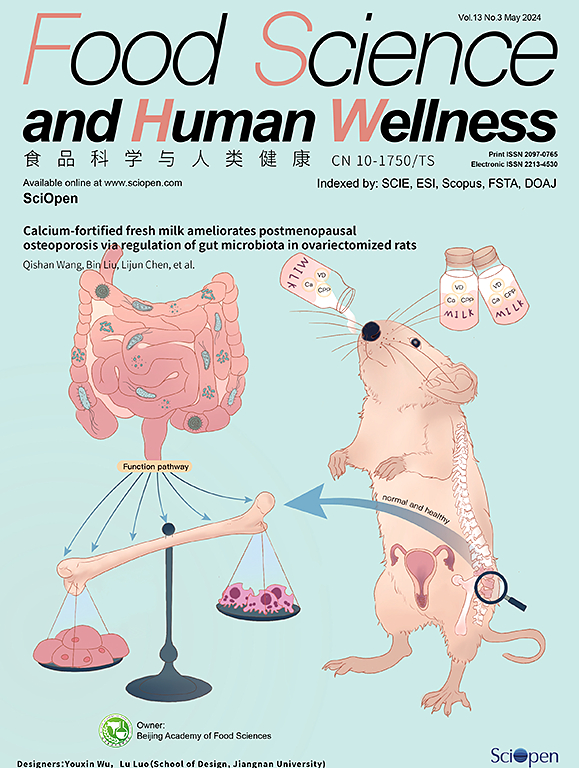柴胡皂苷 D 通过肠道微生物群-胆汁酸代谢途径改善非酒精性脂肪肝
IF 7.4
1区 农林科学
Q1 FOOD SCIENCE & TECHNOLOGY
引用次数: 0
摘要
非酒精性脂肪肝是全球慢性肝病的主要病因。柴胡被广泛用于治疗非酒精性脂肪肝,而柴胡皂苷 D(SSD)是柴胡的主要活性成分之一。本研究旨在探讨柴胡皂苷 D 治疗非酒精性脂肪肝的疗效,并探索基于 "肠肝轴 "的柴胡皂苷 D 改善非酒精性脂肪肝的机制。研究结果表明,SSD能剂量依赖性地缓解高脂饮食诱导的小鼠体重增加,改善胰岛素敏感性,还能减少肝脏脂质蓄积和损伤相关的生物标志物天冬氨酸氨基转移酶(AST)和丙氨酸氨基转移酶(ALT)。进一步研究发现,SSD 可抑制肠道中法尼类固醇 X 受体(Fxr)、小异二聚体伙伴(Shp)、重组成纤维细胞生长因子 15(Fgf15)和顶端钠依赖性胆汁酸转运体(Asbt)的 mRNA 表达水平,这表明 SSD 可通过抑制肠道 FXR 信号转导来改善肝脏脂质代谢。SSD 能显著减少与胆盐水解酶(BSH)表达相关的肠道微生物群,如梭状芽孢杆菌。BSH 表达的减少降低了非结合胆汁酸与结合胆汁酸的比例,从而抑制了肠道 FXR。这些数据表明,SSD 可通过肠道微生物群-胆汁酸-肠道 FXR 途径改善非酒精性脂肪肝,并表明 SSD 是一种治疗非酒精性脂肪肝的有效药物。本文章由计算机程序翻译,如有差异,请以英文原文为准。

Saikosaponin D improves non-alcoholic fatty liver disease via gut microbiota-bile acid metabolism pathway
Non-alcoholic fatty liver disease (NAFLD) is the main cause of chronic liver disease worldwide. Bupleurum is widely used in the treatment of non-alcoholic fatty liver, and saikosaponin D (SSD) is one of the main active components of Bupleurum. The purpose of this study was to investigate the efficacy of SSD in the treatment of NAFLD and to explore the mechanism of SSD in the improvement of NAFLD based on “gut-liver axis”. Our results showed that SSD dose-dependently alleviated high fat diet-induced weight gain in mice, improved insulin sensitivity, and also reduced liver lipid accumulation and injury-related biomarkers aspartate aminotransferase (AST) and alanine aminotransferase (ALT). Further exploration found that SSD inhibited the mRNA expression levels of farnesoid X receptor (Fxr), small heterodimer partner (Shp), recombinant fibroblast growth factor 15 (Fgf15) and apical sodium dependent bile acid transporter (Asbt) in the intestine, suggesting that SSD improved liver lipid metabolism by inhibiting intestinal FXR signaling. SSD can significantly reduce the gut microbiota associated with bile salt hydrolase (BSH) expression, such as Clostridium. Decreased BSH expression reduced the ratio of unconjugated to conjugated bile acids, thereby inhibiting the intestinal FXR. These data demonstrated that SSD ameliorated NAFLD potentially through the gut microbiota-bile acid-intestinal FXR pathway and suggested that SSD is a promising therapeutic agent for the treatment of NAFLD.
求助全文
通过发布文献求助,成功后即可免费获取论文全文。
去求助
来源期刊

Food Science and Human Wellness
Agricultural and Biological Sciences-Food Science
CiteScore
8.30
自引率
5.70%
发文量
80
审稿时长
28 days
期刊介绍:
Food Science and Human Wellness is an international peer-reviewed journal that provides a forum for the dissemination of the latest scientific results in food science, nutriology, immunology and cross-field research. Articles must present information that is novel, has high impact and interest, and is of high scientific quality. By their effort, it has been developed to promote the public awareness on diet, advocate healthy diet, reduce the harm caused by unreasonable dietary habit, and directs healthy food development for food industrial producers.
 求助内容:
求助内容: 应助结果提醒方式:
应助结果提醒方式:


